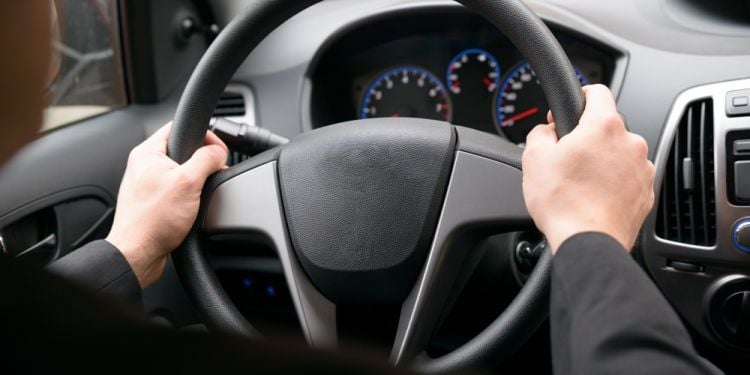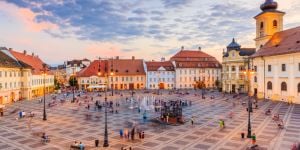
Driving licenses issued in another EU country are also valid in Romania. Other foreign driving licenses are valid in Romania only one year after civil registration. Driving is on the right side. You'll need a driving license or international driving permit, car papers and green card.
Driving licenses issued in other languages than English, French, German and the Nordic languages require a translation into one of these languages attached to the license. If the domestic driving license does not bear a photo, photo identification is required in addition to the driving license. U.S. driver's licenses are only valid in Romania for up to 90 days. Before the 90-day period has expired, U.S. citizens must either obtain an international driving permit in addition to their U.S. driver's license or a Romanian driver's license. For Americans, a passport and valid US driver's license are sufficient for car rental. If you drive your own car, you must purchase a road tax sticker (the "Rovinieta") either from the border or from the nearest gas station. Driving without one will incur a severe fine.
Romanian traffic laws are very strict (although too often they are not enforced). Any form of driver's license or permit can be confiscated by the traffic police for 1-3 months and payment of fines may be requested at the time of many infractions. Some examples are: failure to yield the right of way, failure to yield to pedestrians at crossroads, or not stopping at a red light or stop sign. Romanian traffic law provides for retention of licenses and possible imprisonment from 1 to 5 years for driving under the influence of alcohol (alcohol level over 0.1% limit) or for causing an accident resulting in injury or death. The Romanian police are tough on drunk driving ' controls are very frequent ' and basically any alcohol counts as drunk driving. If you are involved in a car accident while driving and someone is hurt you must stop and wait for the traffic police. Driving away from the scene is considered hit-and-run. Simpler accidents with no injuries can be solved between yourself and all parties involved having to go to a police station and make a statement, but, if in doubt, better phone 112 (Emergency Services) and ask for directions. In most cases, after an accident it is mandatory to take a blood test to establish if the drivers had consumed alcohol. Refusal to undergo this test may be punished with prison ' the punishment is sometimes harsher than the one for drunk driving. The minimum age in Romania for a driving license is 18 years. The use of safety belts is required in both the front and the rear seat, and cars should be driven with dipped headlights, even in the daytime.
Here are some examples of traffic rules:
Wearing a seat belt is mandatory.
Children under 12 years of age cannot be transported in the front seat.
Drivers must yield to pedestrians at all marked pedestrian crosswalks, but many of these are poorly maintained and difficult to see.
Use of mobile telephones while driving is against the law.
Types of roads
a) Motorways (autostrada), having a speed limit of 130 km/h:
A1 - planned to connect Bucharest with cities in southern Transylvania and then proceed to the western border; the only part completed so far is the 110 km long stretch between Bucharest and Pitesti. Arad - Timisoara is under construction, and should be opened by November 2010.
A2 - by 2010 is expected to link Bucharest with the Black Sea port of Constanta; for now, out of the total 225 km length, only the Bucharest - Cernavoda segment (about 150 km) is completed. Cernavoda - Constanta is expected to be completed in early 2010.
b) Expressways (drum expres), having a speed limit of 100 km/h:
The only completed expressway is the 60 km long Bucharest - Giurgiu road. It is in the process of upgrading to motorway standard.
c) National roads (drum national), having a speed limit of 100 km/h:
In the absence of motorways the national roads remain the most important element of the Romanian transport system, as they connect the main cities in the country. They sometimes have 4 non-separate lanes, but many have only two lanes (a notable example is DN1 Câmpina-Brasov - the 100 km mountain stretch can take 6-7 hours to navigate during weekends. Thanks to recent investments most of them are in reasonable condition, but they are frequently overcrowded and (as they pass through villages and cities) rather slow.
d) Other roads, having a speed limit of 90 km/h:
County (drum judetean) and rural (drum comunal) roads are generally in a poor condition compared with national roads (lack of signs, abundant potholes etc.). Some rural roads are covered with gravel.
Useful tips and warnings:
If you are not used to drive on the dark, prepare yourself to drive only daytime: Romanian roads aren't lighted outside towns and villages;
In villages and around you will meet many carriages and domestic animals on the road;
If you travel in winter, be prepared for unclean roads.
If you intend to arrive in Romania around Ester or Christmas and you come from Western Europe, think twice about the day you will cross the border: tens of thousands of Romanians who work in the UE and come home for holidays will be there and you will wait for hours to cross the border.
Road conditions vary widely throughout Romania. While major streets in larger cities and major inter-city roads are in fair to good condition, most other roads are in poor repair, badly lit, narrow, and often do not have marked lanes. Many roads, particularly in rural areas, are also used by pedestrians, animals, people on bicycles, and horse drawn carts that are extremely difficult to see, especially at night. Road travel can be particularly dangerous when roads are wet or covered with snow or ice. This is especially the case concerning mountain roads.
Roads, especially in the mountains, can be particularly dangerous when wet or covered with snow or ice. Winter snow removal, even in cities and on major highways, can be intermittent. Pedestrians, animals, cyclists, and horse-drawn carts share many roads with motor vehicles and can be extremely difficult to see, particularly at night in rural areas. Vehicles often block sidewalks, forcing pedestrians to walk in the streets. Maintain vigilance when driving to avoid hitting those who are walking in the streets. Cross the street only in crosswalks and always look both ways before crossing. Crosswalks are generally poorly marked and drivers may ignore crosswalks even if there is a traffic light.
Bucharest is a very dense and crowded city, with narrow, twisting roads, built mainly in the 19th century, with little traffic in mind. Those roads are suffocated by over 1 million cars - it is possible to take 2 hours to drive a distance that could be walked in 20-25 minutes. Navigation is difficult, a GPS or local guide is a necessity
The host country authority responsible for road safety is the Traffic Police of the Romanian Ministry of Interior. Emergency roadside help and information may be reached by dialing 9271 for vehicle assistance and towing services. For ambulance services, fire brigade or police, dial 112.
Author: Business Support Services for Foreigners in Romania
We do our best to provide accurate and up to date information. However, if you have noticed any inaccuracies in this article, please let us know in the comments section below.






